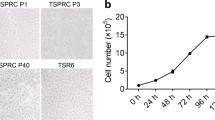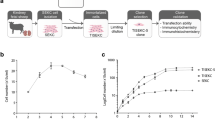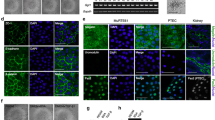Abstract
We established renal cell lines from definite nephron segments which were microdissected from kidneys of transgenic C57BL/6 mice, harboring the large T-antigen gene of temperature-sensitive mutant simian virus 40, pSVtsA58(ori-). Cell culture was under a humidified atmosphere of 5% CO2 in air, on collagen-coated dishes, and in RITC80-7 medium with 5% fetal bovine serum, 10 μg/ml transferrin, 1 μg/ml insulin, 10 ng/ml recombinant human EGF, penicillin and streptomycin. Cell line which kept contact inhibition character was established from each segment. Cells derived from distal tubule, cortical and outer medullary collecting duct possessed their cyclic AMP response to arginine-vasopressin, like their original nephron segment. On the other hand, cells derived from terminal proximal tubules (S3 segment) formed a cobblestone-like confluent monolayer, and did not respond to arginine-vasopressin like their fresh segments. Since cisplatin, a well-known nephrotoxic substance, damages proximal tubules (especially S3) rather than collecting ducts, we assayed cell number, protein content, and ATP content of cultured S3 cells at various times after addition of 0.2 mM cisplatin. Decrease of cell number, total protein content and total ATP content of culture cells occurred after 10 h incubation with 0.2 mM cisplatin. The 50% lethal dose (LD50) of cisplatin in S3 cells was 4×10 – 5 M after 20 h incubation and 8.5×10 – 6 M after 40 h incubation. Outer medullary collecting duct (OMCD) cells were damaged 30% maximally after 20 h incubation with cisplatin, and LD50 in them became 2.5×10 – 5 M after 40 h incubation. We could show that the LD50 of cisplatin in the OMCD cell line was three times higher than that in the S3 cell line. Thus, these cell lines are the first in the kidney to definite the segmental origin and to maintain some differentiated unique functions. They are valuable for studies on intrarenal site-specific actions and possible mechanisms of action of pharmacological and toxic substances.
Similar content being viewed by others
Author information
Authors and Affiliations
Additional information
Received: 3 May 1995 / Accepted 4 September 1995
Rights and permissions
About this article
Cite this article
Hosoyamada, M., Obinata, M., Suzuki, M. et al. Cisplatin-induced toxicity in immortalized renal cell lines established from transgenic mice harboring temperature sensitive SV40 large T-antigen gene. Arch Toxicol 70, 284–292 (1996). https://doi.org/10.1007/s002040050275
Issue Date:
DOI: https://doi.org/10.1007/s002040050275




